|
We continue our exploration of the Healing Yoga for Cancer Survivorship protocol this week with several breathing awareness techniques that may help to reduce stress and create a calmer state of mind. 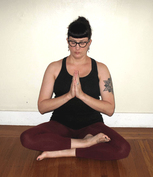 State Your Intention During the first yoga session you will create an intention for your yoga practice. Each time before you practice, sit comfortably with the eyes closed and bring to mind this resolve, state it silently three times with your full awareness.  Vowel Spiral A-E-I-O-U-M Begin in a comfortable seated position (you may sit in a chair if needed).Take a few breaths into the lower belly and exhale naturally through the nose. When you are ready to begin, chant the sounds at a natural speaking pitch. You may also place your hand over the areas of the body where the vibration is strongest.
4-PART BREATH, MUDRA, MANTRA MEDITATION This 4-part breath, mudra and mantra meditation isespecially helpful for fostering emotional well-being. It highlights the four natural parts of the breath cycle with a mudra and mantra to allow the mind to be completely absorbed in the practice and can be used whenever you feel the need to reconnect with the life giving energy that each breath offers and with the trust inherent in our true nature. 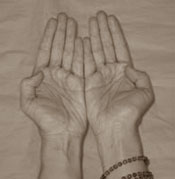 Avhana Mudra Begin in a comfortable seated position (you may also sit in a chair if needed). Turn the palms up touching the pinkie side of the hands together. Press the bent thumbs into base of index finger and keep the other fingers close together. As you inhale, say mentally "I accept" and draw the hands toward the body. Intended Benefits: Increases ability to receive help from others from others 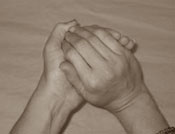 Samputa Mudra Cup hands right over left creating a hollow space between the palms. During the pause after the inhale, say mentally "I am grateful". Intended Benefits: Acknowledges the gifts you carry within  Pushpanjali Mudra Cup hands with little and ring fingertips together creating a offering bowl shape. As you exhale, say mentally "I give" and move hands away from the body. Intended Benefits: Encourages compassion, generosity, giving 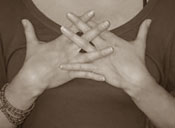 Vajrapradama Mudra Clasp fingers together and open the palms toward heart; point thumbs upwards and hold the hands a few inches away from the heart. During the pause after the exhale, say mentally "I trust" Intended Benefits: Builds confidence, security, and trust BREATHING PRACTICES Bringing conscious awareness to the natural breathing process can have a profoundly relaxing and healing effect on the mind and body. We will practice three techniques here that can be done after your yoga practice or at any time throughout the day; alternate nostril breathing which balances the work of the nervous system, belly breathing which creates a state of peace and calm, and exhale retention which further releases stress and tension. 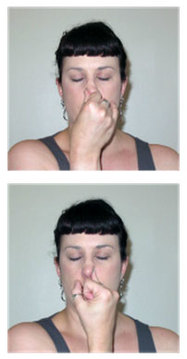 Alternate Nostril Breathing Begin in a comfortable seated position (you may also sit in a chair if needed). Use the right hand and close the right nostril with thumb. Breathe in through the left nostril, the change nostrils by closing the left nostril with the ring finger and breathe out through the right nostril. Breathe back in through the right nostril, then change the fingers again and breathe out through the left nostril. Try to hold the hand directly in front of the face so that you do not have to turn the head. Practice for up to 10 rounds, increasing the number of rounds gently as your comfort level allows. Intended Benefits: Balances the sympathetic nervous system (fight or flight) and the parasympathetic nervous system (rest and digest), increases communication between the right and left hemispheres of the brain.  Belly Breathing Lay on the back with support under the head and knees if needed, close eyes and feel the breath moving in and out of your nostrils. Place the hands on the lower belly. Inhale and feel the fullness in the belly, exhale and feel the surrender in the belly. Practice for up to 5 minutes. Intended Benefits: Calms the nervous system, grounds the emotions, and relaxes the body. 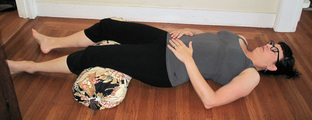 Exhale Retention Lay on the back with support under the head and knees if needed, close eyes and feel the breath moving in and out of your nostrils. Rest the hands on the floor with the palms facing upwards. Inhale into the belly and exhale slowly and completely, extending the length of the exhalation slightly. Begin to rest in the pause after the end of the exhalation for a moment before breathing in. Long slow inhale, longer slower exhale and pause. Practice for up to 5 minutes. Intended Benefits: Calms the nervous system, grounds the emotions, and relaxes the body. 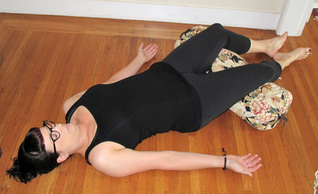 Relaxation Pose Lay on the back with legs straight and feet relaxed to sides. Move arms away from sides slightly and turn palms to face the ceiling. You may use support under the knees for low back pain; and a folded blanket under the head if needed. Rest at least 5 minutes. Intended Benefits: Allows for integration of mind and body after asana practice, promotes restful awareness
0 Comments
Leave a Reply. |
Index:Archives:
September 2022
I attend Cheryl's class regularly and feel that my practice has improved immensely over the past few years due to her expert coaching. Her teaching style is clear and compassionate and her previous experience in teaching adults is evident in her organized approach and easy to understand instructions. I also appreciate that Cheryl not only teaches us about how to correctly position ourselves, but also touches on many aspects of yoga philosophy, which in turn has deepened my personal practice and heightened my awareness of the connection between mind and body, breath and relaxation. |

 RSS Feed
RSS Feed
